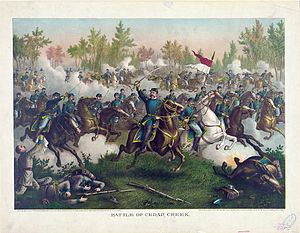Battle of Cedar Creek
| Battle of Cedar Creek (Battle of Belle Grove) |
|||||||
|---|---|---|---|---|---|---|---|
| Part of the American Civil War | |||||||
 Battle of Cedar Creek, by Kurz & Allison (1890). |
|||||||
|
|||||||
| Belligerents | |||||||
|
|
|
||||||
| Commanders and leaders | |||||||
| Philip Sheridan | Jubal Early | ||||||
| Units involved | |||||||
| Army of the Shenandoah | Army of the Valley | ||||||
| Strength | |||||||
|
|
||||||
| Casualties and losses | |||||||
|
5,665
(644 killed;
3,430 wounded; 1,591 captured/missing) |
2,910
(320 killed;
1,540 wounded; 1,050 captured/missing) |
||||||
|
Cedar Creek Battlefield and Belle Grove
|
|
| Built | 1797 |
|---|---|
| Architect | Hite, Isaac |
| Architectural style | Federal |
| NRHP Reference # | 69000243 |
| VLR # | 034-0002 |
| Significant dates | |
| Added to NRHP | August 11, 1969 |
| Designated NHLD | August 11, 1969 |
| Designated NHP | December 19, 2002 |
| Designated VLR | November 5, 1968 |
The Battle of Cedar Creek, or Battle of Belle Grove, fought October 19, 1864, was the culminating battle of the Valley Campaigns of 1864 during the American Civil War. Confederate Lt. Gen. Jubal Early launched a surprise attack against the encamped army of Union Maj. Gen. Philip Sheridan, across Cedar Creek, northeast of Strasburg, Virginia. During the morning fighting, seven Union infantry divisions were forced to fall back and lost numerous prisoners and cannons. Early failed to continue his attack north of Middletown, and Sheridan, dramatically riding to the battlefield from Winchester, was able to rally his troops to hold a new defensive line. A Union counterattack that afternoon routed Early's army.
At the conclusion of this battle, the final Confederate invasion of the North was effectively ended. The Confederacy was never again able to threaten Washington, D.C. through the Shenandoah Valley, nor protect one of its key economic bases in Virginia. The stunning Union victory aided the reelection of Abraham Lincoln and won Sheridan lasting fame.
At the beginning of 1864, Ulysses S. Grant was promoted to lieutenant general and given command of all Union armies. He chose to make his headquarters with the Army of the Potomac, although Maj. Gen. George G. Meade remained the actual commander of that army. He left Maj. Gen. William Tecumseh Sherman in command of most of the western armies. Grant understood the concept of total war and believed, along with Sherman and President Lincoln, that only the utter defeat of Confederate forces and their economic base would bring an end to the war. Therefore, scorched earth tactics would be required in some important theaters. He devised a coordinated strategy that would strike at the heart of the Confederacy from multiple directions: Grant, Meade, and Maj. Gen. Benjamin Butler against Robert E. Lee's Army of Northern Virginia near Richmond; Sherman to invade Georgia and capture Atlanta and Maj. Gen. Nathaniel P. Banks to capture Mobile.
...
Wikipedia
